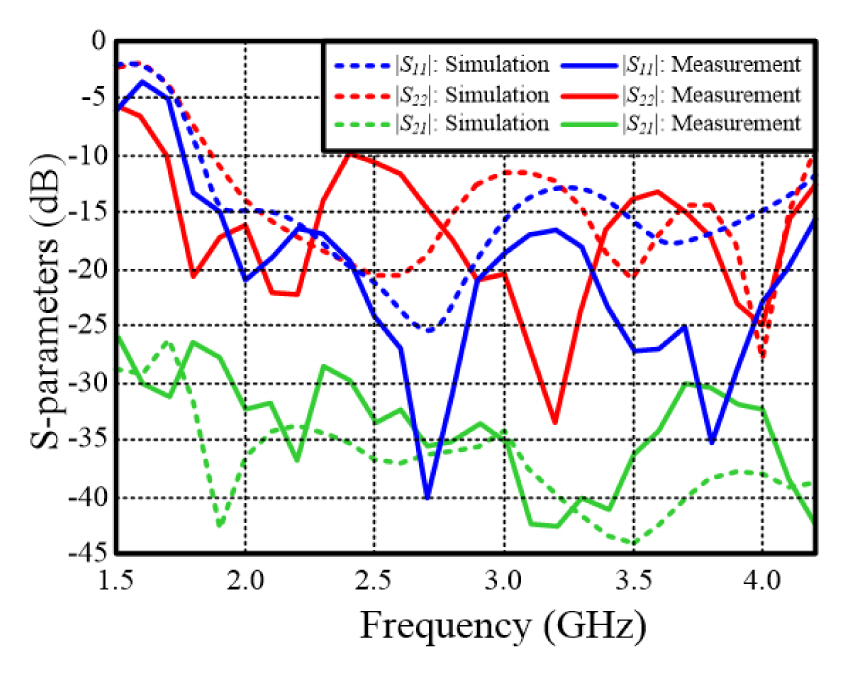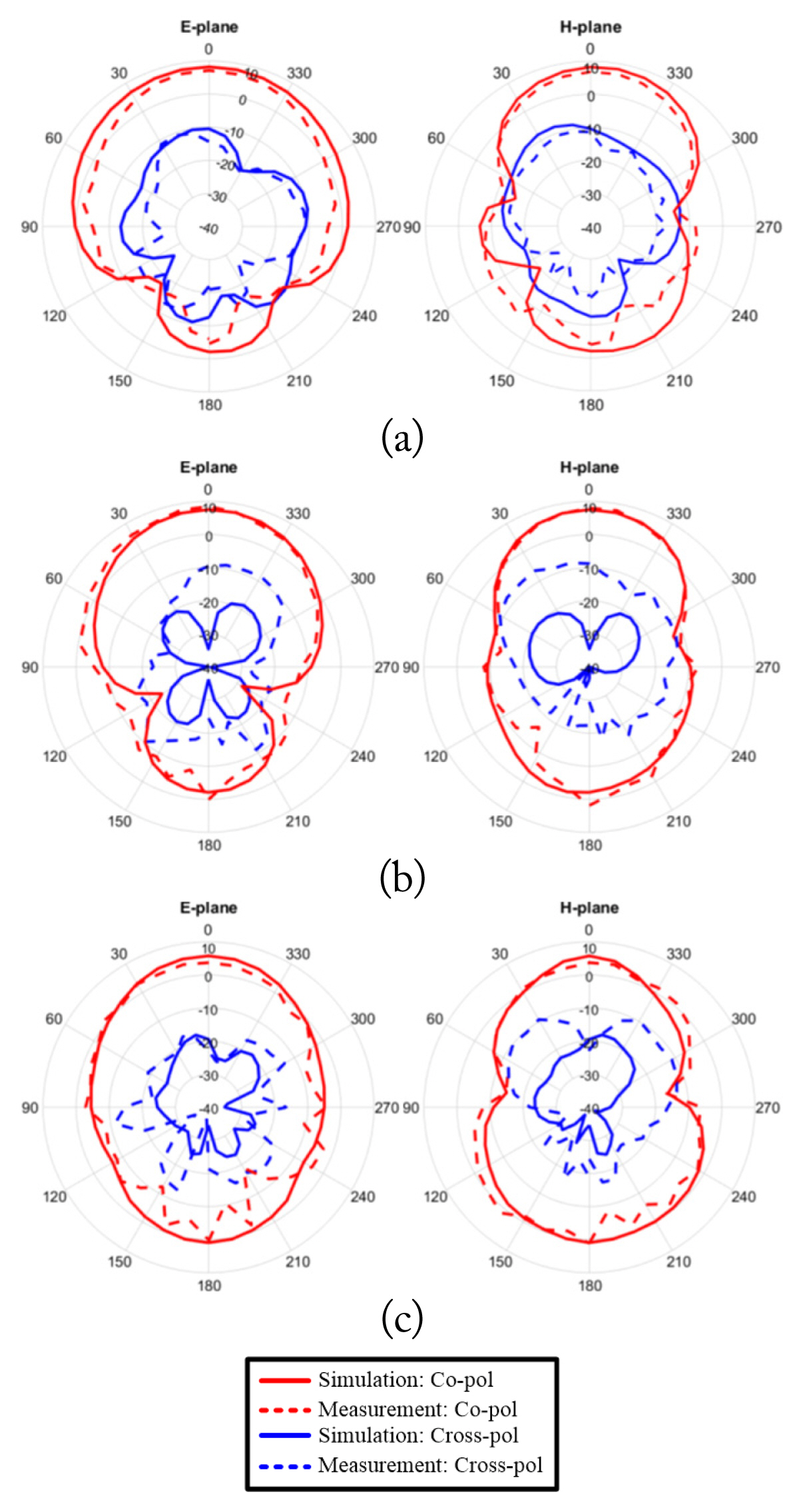A Coupled-Fed Broadband Dual-Polarized Magnetoelectric Dipole Antenna for WLAN and Sub-6 GHz 5G Communication Applications
Article information
Abstract
This paper presents a novel coupled-fed broadband dual-polarized magnetoelectric dipole antenna for wireless local area network (WLAN) and 5G communication applications. The proposed magnetoelectric dipole antenna is composed of a planar electric dipole and shorting pins as a magnetic dipole to obtain a broad operation frequency band. Two coupled microstrip lines perpendicular to each other are coupled through a cross-shaped slot to excite the vertical and horizontal polarizations. The proposed antenna features a simple structure, high gain, and high polarization isolation. The measured impedance bandwidth of the proposed antenna is 1.8–4.2 GHz (fractional bandwidth of 80%). The measured realized antenna gain value is 3.7–8.5 dBi, and polarization isolation level is 25 dB at the operation frequency band.
I. Introduction
The idea of complementary antenna using electric and magnetic dipoles to produce equal E- and H-plane radiation patterns was proposed by Chlavin [1] in 1954. This kind of antenna type has been called a “Huygen’s source” and the magnetoelectric (ME) dipole was invented using electric and magnetic dipoles based on the concept presented in [1]. Numerous antenna designs in line with this idea have been proposed to improve the operational bandwidth of antennas. Recently, a ME dipole antenna structure composed of magnetic and electric dipole antenna topologies was reported. This antenna topology uses both electric and magnetic dipole antennas [2, 3]. In [4], a dual-polarized ME dipole antenna with two Γ-shaped vertical strips was used to excite orthogonal radiation modes. However, the feeding networks of the reported ME dipole antennas are complicated and difficult to implement owing to their 3D structures. In [5], a dual-polarized broadband ME dipole was reported, but it has a crossover section in the feeding network. In [6], a folded vertical magnetic dipole was proposed for a low profile broadband antenna, but dual polarization capability was not implemented.
In this paper, a novel broadband dual-polarized ME dipole with a planar coupled feeding network is presented. The proposed antenna consists of planar electric dipoles and shorting pins for magnetic dipoles. It was excited by two orthogonally placed, U-shaped, open-ended microstrip feeding networks through a cross-shaped slot. The vertical shorting wire pins can be easily connected and aligned to the top radiators and bottom ground (GND) due to the guiding via holes. The designed ME dipole antenna has a symmetric structure, and each U-shaped stub excites vertical or horizontal polarization, resulting in dual-polarization. It should be noted that the proposed antenna is a broadband dual-polarization ME dipole antenna and has a relatively simple structure. The proposed broadband antenna was designed for wireless local area networks (WLAN) and sub-6 GHz 5G communication applications.
II. Antenna Design and Geometry
The geometry of the proposed dual-polarized ME dipole antenna is shown in Fig. 1, and its detailed dimensions are listed in Table 1. The upper part of the antenna is composed of foursquare patches that function as electric dipole antennas (Fig. 1(a)). Each patch had a length of L = 23 mm (0.23λ0) and the antenna height H1 is 20.7 mm (0.21λ0). Unlike other ME dipoles with a vertical shorting plate, the electrical dipoles of the proposed antenna are connected to the ground plane via shorting wires (wire diameter: 1 mm) to form a magnetic dipole structure for ease of fabrication (Fig. 1(b)). The vertical connection and alignment between the electrical and magnetic dipoles are critical fabrication factors. The vertical shorting wires can be easily inserted through the via holes shown in Fig. 1(a) and 1(c), resulting in tight alignment between the top and bottom layers. The ground plane had a cross-shaped slot at the center, and two U-shaped open-ended microstrip lines were coupled to the designed ME dipole through the slot. These two U-shaped microstrip lines were perpendicularly placed to excite the orthogonal modes, as shown in Fig. 1(c). The fabricated antenna prototype is shown in Fig. 1(d). The gray and white parts shown in Fig. 1(d) are 3D printed holders (material: PLA, ɛr = 2.5, tanδ = 0.015) to maintain a constant height and mechanical stability.

Antenna geometry: (a) top, (b) side, (c) bottom views and (d) fabricated antenna prototype with a 3D printed antenna holder.
III. Experimental Results
The measured S-parameters of the proposed ME dipole antenna are shown in Fig. 2. The antenna has a broad bandwidth, given its −10 dB operation frequency bandwidth of 1.8–4.2 GHz (fractional bandwidth: 80%). The discrepancy between the measurement and simulation data was mainly due to the fabrication and the 3D printed antenna holder. The effects of manual soldering and the imperfect cylindrical shape of the vertical wire are also the main sources of error. It should be noted that the polarization isolation level (|S21|) was higher than 25 dB over the entire operation frequency band. Fig. 3 shows the simulated and measured antenna gain values in the frequency band of interest. The simulation results and measurement data agree very well, and the measured average gain value in the operation frequency band (1.8–4.2 GHz) is 7.5 dBi. The vertically and horizontally radiated polarized waves had almost the same antenna gain values. The measured radiation patterns shown in Fig. 4 demonstrate their uniformity over a broad frequency range. The performance of the proposed antenna was compared with that of other reported ME dipoles, as summarized in Table 2. The proposed antenna features a simple planar coupled feeding structure and a broad operation frequency bandwidth.
IV. Conclusion
In this paper, a broadband coupled-fed dual-polarized ME dipole antenna was proposed. The measured antenna bandwidth was approximately 80% (1.8–4.2 GHz). An Orthogonally placed coupled U-shaped feeding network enabled dual-polarization and a high isolation level of 25 dB. The measured peak gain value was 8.6 dBi, and the proposed antenna had broadside radiation patterns. The proposed antenna covers commercial WLAN and sub-6 GHz 5G communication bands.
Acknowledgments
This work was supported by the National Research Foundation of Korea (NRF) grant funded by the Korea government (MSIT) (Grant No. 2020R1C1C1003362).




